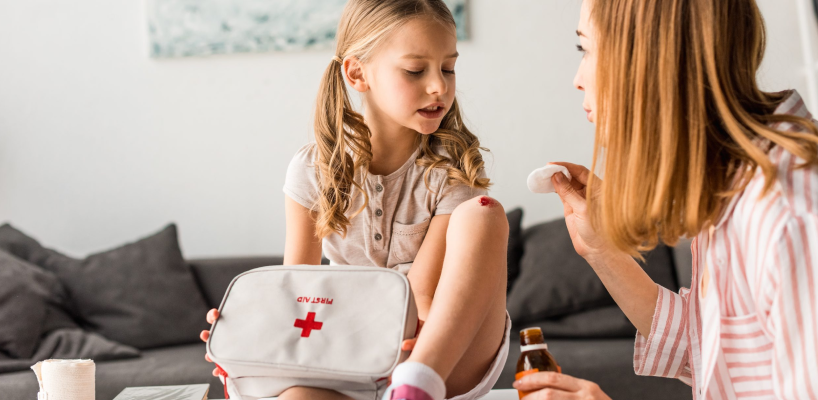Understanding First Aid: Essential Skills for Everyone to Learn
What is First aid? First aid is the immediate care given to someone who is injured or ill before professional help arrives. It saves lives and promotes recovery. There are many types of first aid. These include basic first aid, which covers minor injuries like cuts and burns.
Then we have CPR (Cardiopulmonary Resuscitation) for cardiac emergencies; mental health first aid for psychological crises; and pediatric first aid meant for children. Each type requires specific techniques for different emergencies. Let’s explore the various kinds of first aid through this blog.
What Is First Aid and Why Is It Important?
First aid is a basic yet vital life- skill everyone should know. It saves lives, prevents conditions from worsening, promotes recovery, reduces pain, prevents infections, provides comfort, increases safety awareness, builds confidence, reduces hospital time, and enhances community preparedness. Learning first aid equips individuals to act quickly in emergencies. It ensures better outcomes and leads to a safer environment for all. This is exactly what makes it important.
Read more: Should First Aid be a Part of School Curriculum?
How Can Basic First Aid Techniques Save Lives?
Basic first aid techniques are essential for providing immediate, effective care in emergencies. Here is how it can save lives:
- Performing CPR: Restores breathing and circulation in cardiac arrest cases.
- Stopping Bleeding: Prevents excessive blood loss from wounds.
- Treating Burns: Reduces damage and prevents infections.
- Clearing Airways: Resolves choking incidents quickly.
- Stabilising Fractures: Prevents further injury and pain.
- Managing Shock: Maintains vital functions until help arrives.
- Recognising Heart Attack Signs: Ensures prompt medical intervention.
- Handling Poisoning: Minimizes the impact of toxins.
- Providing Rescue Breaths: Maintains oxygen flow in non-breathing victims.
- Using an AED: Restores normal heart rhythm during sudden cardiac arrest.
What Is Mental Health First Aid and When Should It Be Used?
Mental health first aid involves recognizing and responding to signs of mental health crises, providing initial support, and guiding individuals toward professional help. It should be used to:
- Recognize Symptoms: Identify signs of mental health issues like anxiety, depression, and psychosis.
- Approach the Person: Engage in a compassionate, nonjudgmental conversation.
- Listening Actively: Offer a supportive ear without interrupting or judging.
- Providing Reassurance: Offer comfort and let the person know they are not alone.
- Encouraging Professional Help: Suggest seeking help from mental health professionals.
- Assisting in Crisis: Help manage immediate crises such as panic attacks or suicidal thoughts.
- Maintaining Confidentiality: Respect the person’s privacy and share information only with their consent.
- Educating About Resources: Inform about available support services and resources.
- Supporting Self-Help: Encourage self-care and coping strategies.
- Following Up: Check in regularly to provide ongoing support and encouragement.
How Do You Provide First Aid for Burns?
Knowing the correct steps to take is crucial in managing different types of burns. Let us explore how steps to provide first aid for burns:
- Cool the Burn: Immediately run cool (not cold) water over the burn for 10- 20 minutes.
- Protect the Burn: Cover the area with a sterile, non-stick bandage or clean cloth.
- Avoid Ice: Do not use ice or very cold water, as this can cause further damage.
- Do Not Break Blisters: Leave intact blisters alone to prevent infection.
- Remove Tight Items: Gently remove rings, bracelets, or other tight items before the area swells.
- Elevate the Burned Area: If possible, keep the burned area elevated to reduce swelling.
- Apply Moisturizer: Use aloe vera gel or an antibiotic ointment to keep the area moist.
- Avoid Home Remedies: Refrain from applying butter, oils, or other home remedies.
- Pain Relief: Over-the-counter pain relievers like ibuprofen can help manage pain.
- Seek Medical Attention: Get professional medical help for severe burns, especially those that are deep, large, or on sensitive areas like the face, hands, or genitals.
What Are the Steps Involved in Performing CPR?
CPR (Cardiopulmonary Resuscitation) is a lifesaving technique used in emergencies when someone’s breathing or heartbeat has stopped. Performing CPR promptly can significantly increase the chances of survival.
- Check Responsiveness: Tap the person and shout to see if they respond.
- Call for Help: Dial emergency services and get an AED if available.
- Open the Airway: Tilt the head back slightly and lift the chin to open the airway.
- Check for Breathing: Look, listen, and feel for no more than 10 seconds.
- Give Chest Compressions: Place hands in the center of the chest and press hard and fast, about 2 inches deep at a rate of 100-120 compressions per minute.
- Rescue Breaths: Pinch the nose shut, make a seal over the mouth, and give two breaths, watching for the chest to rise.
- Continue CPR Cycles: Give alternate 30 compressions and 2 breaths until help arrives or the person shows signs of life.
- Use an AED: If an AED is available, follow its prompts as soon as possible.
- Do Not Stop: Continue CPR until emergency responders take over or the person starts breathing normally.
- Monitor the Person: Once breathing resumes, place them in the recovery position and monitor until help arrives.
Read more: Things To Learn In CPR & First Aid Training
Conclusion
First aid is an essential skill that can save lives. Whether it’s basic first aid, CPR, or mental health and pediatric first aid, knowing how to respond makes a great difference.
By learning and applying these techniques, we can increase safety, provide comfort, and ensure timely intervention until professional help arrives. Equip yourself with these skills and understand what is first aid to enhance community preparedness and confidence in handling emergencies.
